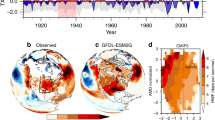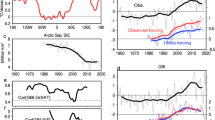Abstract
Previous research found that the warming rate observed for the period 1979–2012 increases dramatically with decreasing vegetation greenness over land between 50°S and 50°N, with the strongest warming rate seen over the driest regions such as the Sahara desert and the Arabian Peninsula, suggesting warming amplification over deserts. To further this finding, this paper explores possible mechanisms for this amplification by analyzing observations, reanalysis data and historical simulations of global coupled atmosphere–ocean general circulation models. We examine various variables, related to surface radiative forcing, land surface properties, and surface energy and radiation budget, that control the warming patterns in terms of large-scale ecoregions. Our results indicate that desert amplification is likely attributable primarily to enhanced longwave radiative forcing associated with a stronger water vapor feedback over drier ecoregions in response to the positive global-scale greenhouse gas forcing. This warming amplification and associated downward longwave radiation at the surface are reproduced by historical simulations with anthropogenic and natural forcings, but are absent if only natural forcings are considered, pointing to new potential fingerprints of anthropogenic warming. These results suggest a fundamental pattern of global warming over land that depend on the dryness of ecosystems in mid- and low- latitudes, likely reflecting primarily the first order large-scale thermodynamic component of global warming linked to changes in the water and energy cycles over different ecosystems. This finding may have important implications in interpreting global warming patterns and assessing climate change impacts.












Similar content being viewed by others
References
Christensen JH, Boberg F (2012) Temperature dependent climate projection deficiencies in CMIP5 models. Geophys Res Lett 39:L24705. doi:10.1029/2012GL053650
Dai A (2006) Recent climatology, variability and trends in global surface humidity. J Clim 19:3589–3606
Dai A (2013) Increasing drought under global warming in observations and models. Nat Clim Change 3:52–58. doi:10.1038/NCLIMATE1633
Davy R, Esau I (2014) Global climate models’ bias in surface temperature trends and variability. Environ Res Lett 9(11):114024
Dee DP, Uppala SM, Simmons AJ, Berrisford P, Poli P, Kobayashi S, Andrae U, Balmaseda MA, Balsamo G, Bauer P, Bechtold P, Beljaars ACM, van de Berg L, Bidlot J, Bormann N, Delsol C, Dragani R, Fuentes M, Geer AJ, Haimberger L, Healy SB, Hersbach H, Hólm EV, Isaksen L, Kållberg P, Köhler M, Matricardi M, McNally AP, Monge-Sanz BM, Morcrette J-J, Park B-K, Peubey C, de Rosnay P, Tavolato C, Thépaut J-N, Vitart F (2011) The ERA-Interim reanalysis: configuration and performance of the data assimilation system. Q J R Meteorol Soc 137:553–597. doi:10.1002/qj.828
Deser C, Walsh JE, Timlin MS (2000) Arctic sea ice variability in the context of recent atmospheric circulation trends. J Clim 13(3):617–633
Dessler AE, Zhang Z, Yang P (2008) Water-vapor climate feedback inferred from climate fluctuations. Geophys Res Lett 35:L20704. doi:10.1029/2008GL035333
Dessler AE, SM Davis (2010) Trends in tropospheric humidity from reanalysis systems. J Geophys Res 115:D19127. doi:10.1029/2010JD014192
Dirmeyer PA, Jin Y, Singh B, Yan X (2013) Trends in land-atmosphere interactions from CMIP5 simulations. J. Hydrometeorol. doi:10.1175/JHM-D-12-0107.1
ECMWF (2013) IFS documentation—Cy40r1, operational implementation 22 November 2013, Part IV: physical processes. http://old.ecmwf.int/research/ifsdocs/CY40r1/
Foster G, Rahmstorf S (2011) Global temperature evolution 1979–2010. Environ Res Lett 6:044022. doi:10.1088/1748-9326/6/4/044022
Fu R (2015) Global warming-accelerated drying in the tropics. Proc Natl Acad Sci USA 112(12):3593–3594. doi:10.1073/pnas.1503231112
Guo ZC, Dirmeyer PA (2013) Interannual variability of land–atmosphere coupling strength. J. Hydrometeorol 14:1636–1646. doi:10.1175/JHM-D-12-0171.1
Hansen J, Ruedy R, Sato M, Lo K (2010) Global surface temperature change. Rev Geophys 48:RG4004. doi:10.1029/2010RG000345
Harris I, Jones PD (2014) CRU TS3.22: Climatic Research Unit (CRU) Time-Series (TS) Version 3.22 of high resolution gridded data of month-by-month variation in climate (Jan. 1901–Dec. 2013). NCAS British Atmospheric Data Centre, 24 September 2014. doi:10.5285/18BE23F8-D252-482D-8AF9-5D6A2D40990C
Held IM, Soden BJ (2000) Water vapor feedback and global warming. Annu Rev Energy Environ 25:441–475
Huete A, Didan K, Miura T, Rodriguez EP, Gao X, Ferreira LG (2002) Overview of the radiometric and biophysical performance of the MODIS vegetation indices. Remote Sens Environ 83:195–213
IPCC (2007) Climate change 2007: the physical science basis, contribution of Working Group I to the Fourth Assessment Report of the IPCC. Cambridge University Press, Cambridge. ISBN:978 0521 88009-1
IPCC (2013) Climate change 2013: the physical science basis, the contribution of Working Group I to the Fifth Assessment Report of the Intergovernmental Panel on Climate Change. Cambridge University Press, Cambridge. ISBN:978-1-107-05799-1
Jeong SJ, Ho CH, Jeong JH (2009) Increase in vegetation greenness and decrease in springtime warming over east Asia. Geophy Res Lett 36:L02710
Jiménez-Muñoz JC, Sobrino JA, Mattar C, Malhi Y (2013) Spatial and temporal patterns of the recent warming of the Amazon forest. J Geophys Res Atmos. doi:10.1002/jgrd.50456
Koster RD et al (2004) Regions of strong coupling between soil moisture and precipitation. Science 305:1138–1140
Lu J, Cai M (2010) Quantifying contributions to polar warming amplification in an idealized coupled general circulation model. Clim Dyn 34:669–687
Lu J, Vecchi GA, Reichler T (2007) Expansion of the Hadley cell under global warming. Geophys Res Lett 34:L06805. doi:10.1029/2006GL028443
Malhi Y, Wright J (2004) Spatial patterns and recent trends in the climate of tropical rainforest regions. Philos Trans R Soc Lond B 359:311–329
McNider RT, Steeneveld GJ, Holtslag AAM, Pielke RA Sr, Mackaro S, Pour-Biazar A, Walters J, Nair U, Christy J (2012) Response and sensitivity of the nocturnal boundary layer over land to added longwave radiative forcing. J Geophys Res 117:D14106
Mitas CM, Clement A (2006) Recent behavior of the Hadley cell and tropical thermodynamics in climate models and reanalyses. Geophys Res Lett 33:L01810. doi:10.1029/2005GL024406
Myhre G, Highwood EJ, Shine KP, Stordal F (1998) New estimates of radiative forcing due to well-mixed greenhouse gases. Geophys Res Lett 25:2715–2718
Nagler PL, Scott RL, Westenburg C, Cleverly JR, Glenn EP, Huete AR (2005) Evapotranspiration on western US rivers estimated using the enhanced vegetation indices from MODIS and data from eddy covariance and Bowen ratio flux towers. Remote Sens Environ 97(3):337–351
Naud CM, Chen Y-H, Rangwala I, Miller JR (2013) Sensitivity of downward longwave surface radiation to moisture and cloud changes in a high elevation region. J Geophys Res 118(17):10072–10081. doi:10.1002/jgrd.50644
Paltridge G, Arking A, Pook M (2009) Trends in middle- and upper-level tropospheric humidity from NCEP reanalysis data. Theor Appl Climatol 98:351–359. doi:10.1007/s00704-009-0117-x
Philipona R, Durr B, Ohmura A, Ruckstuhl C (2005) Anthropogenic greenhouse forcing and strong water vapor feedback increase temperature in Europe. Geophys Res Lett 32:L19809. doi:10.1029/2005GL023624
Pithan F, Mauritsen T (2014) Arctic amplification dominated by temperature feedbacks in contemporary climate models. Nat Geosci 7:181–184. doi:10.1038/ngeo2071
Qu X, Hall A (2007) What controls the strength of snow-albedo feedback? J Clim 20:3971–3981. doi:10.1175/JCLI4186.1
Quan X-W, Hoerling M, Perlwitz J, Diaz H, Xu T (2014) How fast are the tropics expanding? J. Clim 27:1999–2013. doi:10.1175/JCLI-D-13-00287.1
Rangwala I, Sinsky E, Miller RJ (2013) Amplified warming projections for high altitude regions of the northern hemisphere mid-latitudes from CMIP5 models. Environ Res Lett 8:024040. doi:10.1088/1748-9326/8/2/024040
Ruckstuhl C, Philipona R, Morland J, Ohmura A (2007) Observed relationship between surface specific humidity, integrated water vapor, and longwave downward radiation at different altitudes. J Geophys Res 112:L19809. doi:10.1029/2005GL023624
Schneider T, O’Gorman PA, Levine XJ (2010) Water vapor and the dynamics of climate changes. Rev Geophys 48:RG3001. doi:10.1029/2009RG000302
Seager R, Naik N, Vecchi GA (2010) Thermodynamic and dynamic mechanisms for large-scale changes in the hydrological cycle in response to global warming. J Clim 23:4651–4668
Seneviratne SI, Lüthi D, Litschi M, Schär C (2006) Land–atmosphere coupling and climate change in Europe. Nature 443:205–209
Seneviratne SI, Corti T, Davin EL, Hirschi M, Jaeger EB, Lehner I, Orlowsky B, Teuling AJ (2010) Investigating soil moisture-climate interactions in a changing climate: a review. Earth Sci Rev 99(3–4):125–161
Simmons AJ, Willett KM, Jones PD, Thorne PW, Dee DP (2010) Low-frequency variations in surface atmospheric humidity, temperature, and precipitation: inferences from reanalyses and monthly gridded observational data sets. J Geophys Res 115(D1):D01110. doi:10.1029/2009JD012442
Sutton RT, Dong B, Gregory JM (2007) Land/sea warming ratio in response to climate change: IPCC AR4 model results and comparison with observations. Geophys Res Lett 34(2):L02701
Suzuki R, Masuda K (2004) Interannual co-variability found in evapotranspiration and satellite-derived vegetation indices over northern Asia. J Meteorol Soc Jpn 82(4):1233–1241
Taylor KE, Stouffer RJ, Meehl GA (2012) An overview of CMIP5 and the experiment design. Bull Am Meteorol Soc 93:485–498
Thorne PW, Vose RS (2010) Reanalyses suitable for characterizing long-term trends: are they really achievable? Bull Am Meteorol Soc 91:353–361
Thorne PW, Lanzante JR, Peterson TC, Seidel DJ, Shine KP (2010) Tropospheric temperature trends: history of an ongoing controversy. Clim Change, Wiley Interdisciplinary Reviews. doi:10.1002/wcc.80
Trenberth KE, Dai A, van der Schrier G, Jones PD, Barichivich J, Briffa KR, Sheffield J (2013) Global warming and changes in drought. Nat Clim Change 4:17–22
Vose RS et al (2012) NOAA’s merged land–ocean surface temperature analysis. Bull Am Meteorol Soc 93:1677–1685. doi:10.1175/BAMS-D-11-00241.1
Wang KC, Dickinson RE (2012) A review of global terrestrial evapotranspiration: observation, modeling, climatology, and climatic variability. Rev Geophys 50(2):RG2005
Wang K, Dickinson RE (2013a) Global atmospheric downward longwave radiation at the surface from ground-based observations, satellite retrievals, and reanalyses. Rev Geophys 51:150–185. doi:10.1002/rog.20009
Wang KC, Dickinson RE (2013) Contribution of solar radiation to decadal temperature variability over land. Proc Natl Acad Sci 110(37): 14877–14882. www.pnas.org/cgi/doi/10.1073/pnas.1311433110
Wang KC, Liang S (2009) Global atmospheric downward longwave radiation over land surface under all-sky conditions from 1973 to 2008. J Geophys Res 114:D19101. doi:10.1029/2009JD011800
Wild M, Ohmura A, Makowski K (2007) Impact of global dimming and brightening on global warming. Geophys Res Lett 34:L04702. doi:10.1029/2006GL028031
Willett KW, Jones PD, Gillett NP, Thorne PW (2008) Recent changes in surface humidity: development of the HadCRUH dataset. J Clim 21(5364):5383
Wunsch W (2005) The total meridional heat flux and its oceanic and atmospheric partition. J Clim 18:4374–4380. doi:10.1175/JCLI3539.1
Zhou L, Dickinson RE, Tian Y, Vose RS (2007) Impact of vegetation removal and soil aridation on diurnal temperature range in a semiarid region—application to the Sahel. Proc Natl Acad Sci USA 104(46):17937–17942
Zhou L, Dai A, Dai Y, Vose RS, Zou C-Z, Tian Y, Chen H (2009) Spatial dependence of diurnal temperature range trends on precipitation from 1950 to 2004. Clim Dyn 32:429–440. doi:10.1007/s00382-008-0387-5
Zhou L, Dickinson RE, Dai A, Dirmeyer P (2010) Detection and attribution of anthropogenic forcing to diurnal temperature range changes from 1950 to 1999: comparing multi-model simulations with observations. Clim Dyn 35:1289–1307. doi:10.1007/s00382-009-0644-2
Zhou L, Chen H, Dai Y (2015) Stronger warming amplification over drier ecoregions observed since 1979. Environ Res Lett 10:064012. doi:10.1088/1748-9326/10/6/064012
Acknowledgments
This study was supported by National Science Foundation (NSF AGS-1247137 and AGS-1535426). H.C. was funded by National Natural Science Foundation of China (Grant Number 41230422). N.W. was supported by the China Scholarship Council (CSC) and by the University at Albany, State University of New York.
Author information
Authors and Affiliations
Corresponding author
Rights and permissions
About this article
Cite this article
Zhou, L., Chen, H., Hua, W. et al. Mechanisms for stronger warming over drier ecoregions observed since 1979. Clim Dyn 47, 2955–2974 (2016). https://doi.org/10.1007/s00382-016-3007-9
Received:
Accepted:
Published:
Issue Date:
DOI: https://doi.org/10.1007/s00382-016-3007-9




